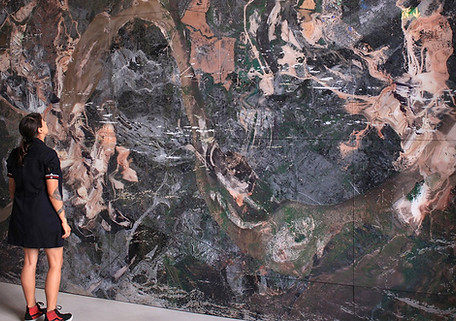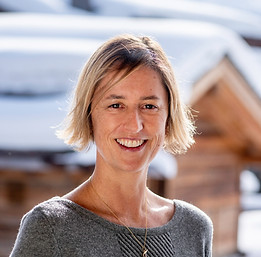NEW YORK DEBATE
Verbier Debate + live Q&A | Video by Crossmark | 1:02:05
New York Debate key summary:
-
We need to re-assess our cultural spaces, habits and structures to find new myths and new rituals.
-
The holistic knowledge of indigenous people plays a fundamental role in helping us reinvent our relationship with nature.
-
To have any hope to stop climate change, a total rethink of our values is needed.
The New York Debate (1:02:05 mins) is moderated by Jessica Morgan, 2020 Summit partner and director of the Dia Art Foundation, and features:
02:12 – Andrea Bowers, artist
08:26 – Carolina Caycedo, artist
15:00 – Elvira Dyangani Ose, Director of The Showroom London
22:56 – Panel discussion
46:23 – Live Q&A
The New York Debate focused on how we can reassess our spaces and systems of culture to find more sustainable ways of operating. The process of rethinking our values should take into consideration the knowledge of indigenous communities who can teach us how to build a respectful relationship with the environment.
We need to re-assess our cultural spaces, habits and structures to find new rituals and new experiences that can contribute to environmental awareness.

Carolina Caycedo, Video still, 2021 Verbier Art Summit
Carolina Caycedo explains how her artistic work addresses topics like privatisation of resources, loss of biodiversity and environmental justice. In artworks such as To Stop Being a Threat and To Become a Promise (2017), Carolina highlights the possibility of art ‘to break the kind of authoritarian spell’ that corporate images and oppressive structures cast on us as a society. In this sense, art is a form of ‘visual resistance’. By reconnecting with the past and unlearning oppression, we can manage to look at nature without the colonizer gaze. She also invites us to become aware of the role each of us has in our
communities, by asking “If I’m the artist of my block, what can I give to my neighbours as an artist?” Elvira Dyangani Ose, whose curatorial work focuses on collaborative practices and socially engaged artworks, agrees on this point. She talks about the ‘human dimension’ that institutions should pursue. For instance, mentioning one of the projects at The Showroom London, COVID MANIFESTO (2020), by artist Cauleen Smith, which allowed for the intimacy of the artist’s studio to be brought into the public realm. In her view, institutions should explore alternative ways in which knowledge is transmitted and challenge the norms of their spaces by giving a platform to artists who work outside of the mainstream.
The holistic knowledge of indigenous people, who have cared for the land for generations, plays a fundamental role in helping us reinvent our relationship with nature.

Andrea Bowers, My Name Means Future, 2020
The work of artist Andrea Bowers focuses on ‘under-documented histories’ such as the struggles of indigenous people and environmental activists. An example of this is the documentary My Name Means Future (2020) in which Andrea interviewed Tokata Iron Eyes, a member of the Standing Rock Sioux tribe who has been involved with the movement to stop the Dakota Access Pipeline. In Andrea’s view, the role of the artist is to help people unlearn the untrue stories they have been taught through education, so that these stories can be told in more accurate ways. Both Andrea and Carolina agree on the importance of the Land Back Movement which fights for the return of all public lands to indigenous people. Carolina highlights how indigenous communities have always been the best stewards of biocultural diversity. They represent a kind of embodied knowledge that they carry with them through
memory and rituals. Indigenous people match theory and practice: how they act in everyday life reflects their beliefs that the natural elements are sacred and should be managed with utmost care. Carolina invites us to look back in order to move forward, as the answers to our current problems can be found in the ancient knowledge of Indigenous communities.
To have any hope to stop climate change, a total rethink of our values is needed.
Andrea believes that re-imagining our cultural values can be done through the work of youth activists, who are more sensitive to environmental issues. Moreover, she thinks that the first step to stop climate change, is to get involved locally within your community. Local action can, in turn, contribute to global changes. Referring to one of her slogans ‘Grief and Hope’, she stresses the importance of not ignoring the environmental grief we feel whenever a tree is cut or a forest is burning. Elvira expands on this point, suggesting that care should be the foundational value of a new myth for our society. For this to happen, the engagement of cultural institutions, communities and non-human collaborators is fundamental. Art has the power to create an active citizenry and to build communities around a sense of critical awareness. Indeed, the artist is not at the top of a pyramid, but is part

Andrea Bowers, Grief and Hope, 2020
of a collective consciousness. Referring to the work of Andrea and Carolina, Elvira concludes by wondering: “Can dissidence be an act of profound generosity?”

Carolina Caycedo, Yuma, or the Land of Friends, 2014

Ye'kwana Leadership Forum, The Shaman’s Message, 2020
Carolina Caycedo is one of the artists featured in the 23rd Biennale of Sydney titled rīvus (12 March – 13 June 2022), which showcases rivers and freshwater ecosystems as living creatures with different degrees of political agency.
Click here to learn more.
Watch the short movie The Shaman’s Message produced by Ye'kwana Leadership Forum which invites humankind to listen to indigenous communities in order to survive climate change and the destruction of biodiversity.

Collective Intimacy: A Live Programme at The Showroom London
The Showroom London is part of the 15 UK public arts organisations which joined forces on one centralised open-access platform called theVOV which launched on 19th April 2021. With 3 seminal shows launching every Monday, the initiative combines cutting edge XR technology with a pioneering micro-philanthropic model.

LANDBACK Movement Banner
Andrea Bowers encourages us to read more about the Land Back Movement which aims to build lasting sovereignty over the lands of indigenous people.
CURRICULUM VITAE

Andrea Bowers
Andrea Bowers is a Los Angeles-based American artist working in a variety of media including video, drawing and installation. Andrea received her MFA from the California Institute of the Arts in 1992. Over the last twenty-three years, her work has explored social issues ranging from women’s or worker’s rights to climate change. Her work converges between art and activism and has been exhibited around the world, including museums and galleries in Germany, Greece and Tokyo.
Photo by Alpimages

Carolina Caycedo
Carolina Caycedo is a London-born Colombian multidisciplinary artist known for her performances, videos, artist’s books, sculptures and installations that examine environmental and social issues. She participates in movements of territorial resistance, solidarity economies, and housing as a human right. Her work contributes to the construction of environmental historical memory, as a fundamental element for non-repetition of violence against human and non-human entities. Among others, she held residencies at the DAAD in Berlin, and The Huntington Libraries, Art Museum and Botanical Gardens in San Marino, California; received funding from Creative Capital, and Prince Claus Fund; participated in the Chicago Architecture, Sao Paulo, Istanbul, Berlin, and Whitney Biennials. Carolina’s recent and upcoming solo shows include Care Report at Muzeum Sztuki in Łódź; Wanaawna, Rio Hondo and Other Spirits at Orange County Museum of Art; Cosmoatarrayas at ICA Boston; and From the Bottom of the River at MCA Chicago. Carolina is the 2020 Wanlass Artist in Residence at Occidental College in Los Angeles, and a 2020-2022 Inaugural Borderlands Fellow at the Center for Imagination in the Borderlands at Arizona State University, and the Vera List Center for Art and Politics at The New School. She is a member of the Los Angeles Tenants Union and the Rios Vivos Colombia Social Movement.
Photo by Ruben Diaz

Elvira Dyangani Ose
Elvira Dyangani Ose is Director of The Showroom, London. She is affiliated to the Department of Visual Cultures at Goldsmiths and the Thought Council at the Fondazione Prada. Previously, she served as Creative Time Senior Curator, Curator of the eighth edition of the Göteborg International Biennial for Contemporary art, and Curator International Art at Tate Modern. She recently joined Tate Modern Advisory Council. Elvira has published and lectured on modern and contemporary African art and has contributed to art journals such as Nka and Atlántica. She studied a Doctoral Degree in History of Art and Visual Studies at Cornell University, New York; has a MAS in Theory and History of Architecture from Universitat Politècnica de Catalunya, Barcelona; and a BA in Art History from Universitat Autònoma de Barcelona.
Photo by Maureen M. Evans

Jessica Morgan
Jessica Morgan joined Dia Art Foundation as Director in January 2015 and was named Nathalie de Gunzburg Director in October 2017. At Dia, Morgan is responsible for strengthening and activating all parts of Dia’s multivalent program, including its pioneering Land art projects, site-specific commissions, and collections and programming across its constellation of sites. Since Morgan’s arrival at Dia, the foundation has grown and diversified its collection to include significant works by Mary Corse, Nancy Holt, Robert Morris, Dorothea Rockburne, Kishio Suga, Anne Truitt, and Lee Ufan among others.
Alongside an expanded exhibition program, Morgan has continued Dia’s commitment to site-specific commissions, facilitating major new work by artists including Isabel Lewis, Rita McBride and Joëlle Tuerlinckx, and in 2015 realizing the first Dia commission outside the continental United States since 1982 with Allora & Calzadilla’s Puerto Rican Light (Cueva Vientos), situated in Puerto Rico. In 2018, Morgan announced a comprehensive, multi-year campaign, that includes the upgrade, revitalization, and ongoing stewardship of Dia’s key programmatic spaces and artist sites.
Photo by Alpimages
ART, SCIENCE AND CULTURAL INSTITUTIONS IN THE ECOLOGICAL CRISIS

